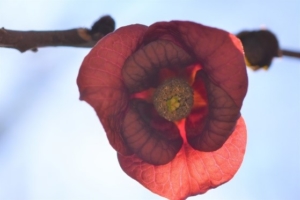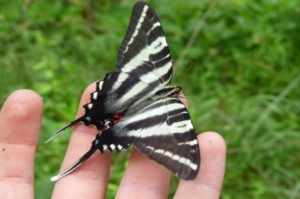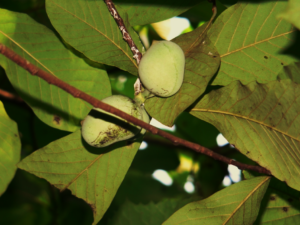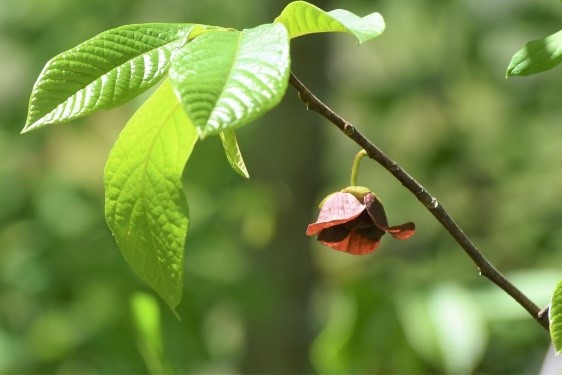Near to Nature: Pawpaws

Pawpaw flower. Pawpaw trees boom in April, but fruit in the fall.
The Pawpaw (Asimina triloba) is a small, native fruit tree growing in floodplain forests and creekbeds throughout the Appalachian Mountains. Pawpaws are recognized by their enormous, paddle-shaped leaves and slender, greenish trunk, seldom growing over twenty feet tall. When scratched, the broad, lush-green leaf of a pawpaw smells slightly like diesel fuel, and every spring the trees bear dark, reddish-black flowers. These beautiful, exotic flowers dangle from each branch, but they also have a dark secret. The luscious flowers smell faintly like carrion to attract flies and beetles as pollinators, and after a brief period of blooming, the little trees remain tucked away for the rest of the summer. Due to their unique, shade-tolerant biology, they thrive under the dark, cool canopy of tall oaks, hickories, and tulip-trees. The pawpaw seems to be kind of a smelly, nasty tree, right?
Not so! The pawpaw has an amazing life history and gives life to a wide variety of native animals. Those enormous leaves are the only host plant of our beloved Tennessee state butterfly, the Zebra Swallowtail (Eurytides marcellus) and their shade and size provides habitat for hundreds of other insects, birds, and “herps” (reptiles & amphibians). However, by mid-September, the tree becomes much more attractive to both animals and people. How? The pawpaw fruits begin to ripen!

Zebra Swallowtail.
The hefty fruits of the pawpaw are generally edible to humans, and both look and taste somewhat like a banana and a pear mixed and wrapped in the same peel. Buried deep under the yellow, sugary pulp of the fruit, are lines of enormous, woody and kidney-bean-sized seeds. And the pawpaw has a very strategic way of spreading them. Like most fruits, especially wild fruits, pawpaws have a powerful laxative effect. Since pawpaws just happen to be the favorite food of raccoons and black bears gorging for the cold winter months ahead, the unsuspecting animals fall for the trap. Just after pawpaw season, even into November, raccoon scat can be seen abundantly along trails and woodland corridors. What’s within each pile? Dozens of pawpaw seeds. Digestion (or another disturbance, like “scarification”) causes water to enter the seed coating and allows the seed to germinate. Without larger mammals, pawpaws would seldom be spread across the mountains. Like several other large, seemingly out-of-place native fruits, some hypotheses state that mammoths and mastodons that formerly roamed the region first carried the seeds into the region. Today, even box turtles, deer, wild turkeys, and many other species of wildlife scour the forest for pawpaws in the fall.
Even songs like “Way Down Yonder in the Pawpaw Patch” and colloquial names like “West Virginia Banana” honor the charismatic, tasty fruit. It’s hard to ignore an enormous fruit tree like the pawpaw that occurs naturally throughout the United States. However, pawpaws are becoming increasingly threatened in parts of the nation and are considered an endangered species in a few different states. Habitat destruction, drought, and competition with invasive-exotic species can easily wipe out a population of pawpaw trees. Thankfully, protected habitats like Bays Mountain allow wild pawpaw groves to thrive without human disturbance in the dense, warm floodplain forests where they grow verdantly. See if you can spot a pawpaw tree the next time you hike around the lake, and you might even catch a glimpse of wildlife searching for the tree’s tasty fruit!

A cluster of pawpaw fruit, ready to ripen and fall.
Both the Cherokee and Yuchi tribes around Bays Mountain were harvesting pawpaws long before European settlement harvested by finding a tree around four inches in diameter or wider, shaking the trunk profusely, and catching the swollen, juicy fruits as they catapult to the ground. In fact, pawpaws were also cultivated in orchards around their villages; the remnants of these “pawpaw gardens” can still be found growing in parts of East Tennessee today. Since then, many Spanish explorers, French, English, and Scots Irish settlers wrote about surviving the latter part of summer and fall by eating this fruit; sometimes almost solely. In modern times, pawpaws are mainly eaten for pleasure rather than necessity. The fragile, easily bruised fruits make them unsuitable for commercial production, but many recipes, such as pawpaw ice cream, “pawpaw butter,” and all sorts of pies and cakes arose from this abundant fruit’s bounty, which have been cherished and passed down as prized heirlooms through the generations in Appalachia.







